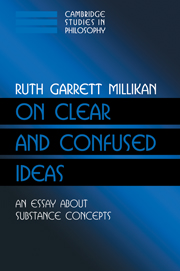Book contents
- Frontmatter
- Contents
- Preface
- Chapter 1 Introducing Substance Concepts
- Chapter 2 Substances: The Ontology
- Chapter 3 Classifying, Identifying, and the Function of Substance Concepts
- Chapter 4 The Nature of Abilities: How Is Extension Determined?
- Chapter 5 More Mama, More Milk and More Mouse: The Structure and Development of Substance Concepts
- Chapter 6 Substance Concepts Through Language: Knowing the Meanings of Words
- Chapter 7 How We Make Our Ideas Clear: Epistemology for Empirical Concepts
- Chapter 8 Content and Vehicle in Perception
- Chapter 9 Sames Versus Sameness in Conceptual Contents and Vehicles
- Chapter 10 Grasping Sameness
- Chapter 11 In Search of Strawsonian Modes of Presentation
- Chapter 12 Rejecting Identity Judgments and Fregean Modes
- Chapter 13 Knowing What I'm Thinking Of
- Chapter 14 How Extensions of New Substance Concepts are Fixed: How Substance Concepts Acquire Intentionality
- Chapter 15 Cognitive Luck: Substance Concepts in an Evolutionary Frame
- Appendix A Contrast with Evans on Information-Based Thoughts
- Appendix B What Has Natural Information to Do with Intentional Representation?
- References
- Index
Chapter 4 - The Nature of Abilities: How Is Extension Determined?
Published online by Cambridge University Press: 02 December 2009
- Frontmatter
- Contents
- Preface
- Chapter 1 Introducing Substance Concepts
- Chapter 2 Substances: The Ontology
- Chapter 3 Classifying, Identifying, and the Function of Substance Concepts
- Chapter 4 The Nature of Abilities: How Is Extension Determined?
- Chapter 5 More Mama, More Milk and More Mouse: The Structure and Development of Substance Concepts
- Chapter 6 Substance Concepts Through Language: Knowing the Meanings of Words
- Chapter 7 How We Make Our Ideas Clear: Epistemology for Empirical Concepts
- Chapter 8 Content and Vehicle in Perception
- Chapter 9 Sames Versus Sameness in Conceptual Contents and Vehicles
- Chapter 10 Grasping Sameness
- Chapter 11 In Search of Strawsonian Modes of Presentation
- Chapter 12 Rejecting Identity Judgments and Fregean Modes
- Chapter 13 Knowing What I'm Thinking Of
- Chapter 14 How Extensions of New Substance Concepts are Fixed: How Substance Concepts Acquire Intentionality
- Chapter 15 Cognitive Luck: Substance Concepts in an Evolutionary Frame
- Appendix A Contrast with Evans on Information-Based Thoughts
- Appendix B What Has Natural Information to Do with Intentional Representation?
- References
- Index
Summary
ABILITIES ARE NOT DISPOSITIONS OF THE MOST COMMON SORT
The conception you have of a substance does not determine the extension of your concept. The extension is the extent of a certain substance in nature, not whatever you would identify as part of the extension. But the extent of which substance? That question is crucial. What determines, in the particular case, what particular substance one's perhaps stumbling, sketchy, and inadequate conception is aiming at? This chapter will make some progress toward answering that question. Further pieces of the puzzle will be added in Chapter 5, and the last pieces will finally settle into place at the end of Chapter 14.
Substance concepts are abilities of a certain kind. They are, in part, abilities to reidentify their assigned substances. How are these substances assigned? It is not a function of the cognitive systems as handed down by natural selection to identify any particular substance. Natural selection did not endow me with the ability to identify either 1969 Plymouth Valiants, or gasoline, or my husband. What I was endowed with was the capacity to acquire these abilities. Thus the general form of the question what determines the reference of a certain substance concept is: What determines what a learned ability is an ability to do? It will help to tackle the matter in this entirely general form.
The question of what abilities are deserves a lot of attention that it hasn't gotten.
- Type
- Chapter
- Information
- On Clear and Confused IdeasAn Essay about Substance Concepts, pp. 51 - 68Publisher: Cambridge University PressPrint publication year: 2000

